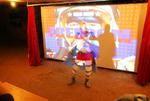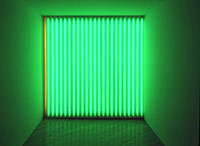Ousmane Sembene on WNYC, of course, which I already posted
John Waters on WPS1 [although for my money, no Waters interview is better than this Oct 1998 dicussion of Pecker on Fresh Air, which makes me cry laughing to this day.]
Melvin Van Peebles from 1971, speaking at MoMA about his just-released Sweet, Sweetback’s Badassss Song.
WPS1‘s been getting its groove on lately, in case you haven’t noticed. The talk shows are tightening up a bit, and the music is rocking. Now if they can only figure out podcasting…
Author: greg
I Scoopa de World, Chico, ‘n everthin’s’innit
These are the first color photographs released of Les Arenes de Chaillot. They’ll be running this weekend in Le Monde.
Supposedly, the staff of La Mexicaine de Perforation are dressed like this for the screening of Mister Freedom and Sgt Kabukiman.
That, or this whole underground cinema thing is really a publicity stunt for Fox’s upcoming The Tick: The Musical.


Muchas gracias por todo, Mexicaines!
Previously on greg.org:
Les Arenes de Chaillot: complete programme guide
Exclusive: La Mexicaine Le Interview
Search results for “Mexicaine”
Happy (Belated) 2nd Birthday to Gawker
Which was registered two years ago last week, it turns out.
Registrant:
Pending Renewal or Deletion
P.O. Box 430
Herndon, VA 20172-0447
US
Phone: 570-708-8786
Domain Name: GAWKER.COM
Record expires on 05-Oct-2004
Record created on 05-Oct-2002
Update: Trying to think of a gift for Gawker? They already got a sharp stick in the eye from Network Solutions… (Nick says the whole thing’s an NSI screwup, although I’d suspect BMW.)
Les Arenes de Chaillot: The Complete Programme Guide
If greg.org were a magazine, this would be the big sidebar. But you can call it what it is: whoring for traffic. Here, for the first time in the indexable media, are the programmes–complete with my poor translations of their film descriptions–of La Sesion Comoda and Urbex Movie, the 2003 and 2004 series, respectively, organized by La Mexicaine de Perforation.
Screenings began at midnight in Les Arenes de Chaillot, the group’s underground cinema adjacent to la Cinematheque Francaise.

Continue reading “Les Arenes de Chaillot: The Complete Programme Guide”
I wanna de world, Chico, n’everthin’s’innit
On the long-anticipated convergence of films and video games: on City of Sound, Dan Hill points out GTA3: Vice City‘s remarkable multitude of similarities to Scarface, from the landscape, to the music, to the interior decorating details of Tony Montana’s mansion.
Scarface is Vice City is Scarface [City of Sound]
They Shoot Houses, Don’t They?
My mother’s house was recently scouted as a location for this season of The WB’s Everwood. She didn’t want all those people stomping across her limestone, so she turned them down.
But according to the LA Times, some homeowners say yes, again and again. Says one location manager who has booked Pierre Koenig’s Case Study House No. 22 for many films, “You can shoot a McMansion anytime you want, and no one will remember it. It just satisfies my creative juices to get great architecture into movies.”
Using the same houses for every movie? Sounds about as creative as casting Negroes as servants. But that’s L.A., always trying to shoot around the palm trees.
Best House in A Leading Role [LAT, via Towleroad]
Related: Wes Anderson’s Dream House [NYO]
The owner of the New Jersey McMansion used as a set for The Sopranos claims 250 replicas have already been built using his $699 Soprano Home Design blueprints [NYT 08/2002, via City of Sound]
Yow. Guardian gets all in Pinault’s business
Viva La Revolution! The Guardian‘s loyal apparatchik, Amelie Gentleman demands that contemporary art collector, museum-builder, Frenchman, and “rapacious capitalist” Francois Pinault confess his artistic crimes.
Crimes number one, two, and three: pouring hundreds of millions of his own euros into to build a world-class collection–the likes of which doesn’t exist anywhere else in France–and to turn a ruined factory–or, as she calls it, the “temple of France’s workers”–into a Tadao Ando-designed museum.
She tries to scare France senseless by comparing Pinault to the mad king of London’s art world, Charles Saatchi. But she’s got almost all hyperbole, almost no data, and next to no quotes, except for a bitchy whispering “official,” who’s righter than he knows when he says most French contemporary artists aren’t good enough to make the collection (Don’t worry about them, though; their ’68 buddies entrenched at the Pompidou will always buy their work.)
After living all these years in dread of Saatchi, Gentleman’s article sounds like a case of the abused becoming the abuser.
Saatchi of the Seine [Guardian]
Exclusive: La Mexicaine Le Interview

While the discovery of an underground cinema in the center of Paris has been widely covered, little or no attention has been paid to what the films actually played there. Les Arenes de Chaillot (The Chaillot Arenas) was created by La Mexicaine de Perforation, a group of self-labeled urban explorers who, for the last five or so years, have used the invisible and forgotten infrastructure of Paris as their own curatorial venue, putting on exhibitions, concerts, and, beginning last year, film screenings.
Early Sunday morning I spoke with Lazar Kunstmann, a filmmaker, editor, and the public spokesman of LMDP about the group’s objectives, ideas, and inspirations. Turns out there were at least two weekly film series, including Urbex Movie, the one that someone narc’ed out this past summer. Here’s what they showed and why:
On & On & On
 You have 9 days and counting to see David Zwirner’s show of 40 years of On Kawara’s date paintings. Kawara began painting these works on January 6, 1966, and he has developed a particular set of rules for their creation: he must complete the painting by the end of that day; the date format is determined by the country where he happens to be (Esperanto where they don’t use Roman characters, and always hand-painted, not stencilled); there are eight color (mixed fresh every day) and five size variations; he eventually stopped including a page from that day’s local newspaper in the box.
You have 9 days and counting to see David Zwirner’s show of 40 years of On Kawara’s date paintings. Kawara began painting these works on January 6, 1966, and he has developed a particular set of rules for their creation: he must complete the painting by the end of that day; the date format is determined by the country where he happens to be (Esperanto where they don’t use Roman characters, and always hand-painted, not stencilled); there are eight color (mixed fresh every day) and five size variations; he eventually stopped including a page from that day’s local newspaper in the box.
While working with a strict, uniform, and imposed subject matter, Kawara’s method offers subtle reminders of the act of making, little shoutouts of “I am still alive.”
Just as Dan Flavin’s work uses the barest means to make us aware of space, Kawara’s makes us aware of time. Why do I suddenly have the urge to see I ♥ Huckabees?
On Kawara at David Zwirner, through Oct. 16
On Kawara at Dia:Beacon, the second-largest grouping around. Also check out Lynne Cooke’s essay.
Other Kawara-related posts, including Kawara’s amazing piece at Documenta XI
Set your TiVo’s on ‘Stun’
John Edwards is hosting Dr. Strangelove tonight on Turner Classic Movies. [via fimoculous]
The only bummer is that Kubrick fingered the generals, not the chickenhawks. Still, I’d be less nervous sharing the screen with Dick Cheney than with George C. Scott. Sellers isn’t bad, either.
Three other senators picked movies so predictable you’d think they were up for election this year: McCain (Paths of Glory), Biden (Dead Poets Society), and Hatch (To Kill A Mockingbird).
Party Politics and The Movies Series on TCM
RNC Highlight Reel
Don’t know the editor, but the actors are familiar, and the script, we all know it by heart now (“September 11th, Saddam Hussein, very dangerous, global terrorism”).
BoingBoing points to a video that distills the 4-day message of last month’s Republican National Convention into three or so rhythmic minutes. The award for Most Hysterical goes to New York’s own Rudy Giuliani.
How Do You Run A Convention On A Record Of Failure? [via BoingBoing]
I See Alec Baldwin as Gandolfini
Today’s Boldface Names column in the Times is a ready-to-shoot script for a Hemingwayesque short. The story: James Gandolfini, who’s putting the Ernest H. in HBO, gets into character by putting the moves on…on the reporter for the New York Times. The whole thing takes place during a benefit at Elaine’s.
I’d shoot this myself, but I’m still too traumatized over losing my shaving kit last week on the exact spot where this love scene takes place. Think about it.
The Old Man and the She [NYT, via Gawker]
This Week In: BYU In The News
I love this place: BYU newspaper yanks T-shirt ad [Deseret News]
And I love these t-shirts: I Cant…I’m Mormon
MPAA: The Tenth Time’s The Charm
And I’m proud to be an American, where at least I know I’m free…to take children to see simulated puppet sex.
Kudos to the MPAA censors–now sitting in their collective bed smoking a Marlboro Light–who made the producers of Team America World Police come ten times
I Have Seen The Light
 And it is good. Just got back from the newly opened Dan Flavin retrospective at the National Gallery this morning, and it’s pretty wonderful. Some of the galleries are oddly cramped–anyone realize how unfriendly I.M. Pei’s actual galleries are to art?–especially if you’re used to seeing Flavins in dedicated spaces like Dia:Beacon, Dia:Bridgehampton, or Judd’s Spring St. loft.
And it is good. Just got back from the newly opened Dan Flavin retrospective at the National Gallery this morning, and it’s pretty wonderful. Some of the galleries are oddly cramped–anyone realize how unfriendly I.M. Pei’s actual galleries are to art?–especially if you’re used to seeing Flavins in dedicated spaces like Dia:Beacon, Dia:Bridgehampton, or Judd’s Spring St. loft.
But every time I start to write how there are too many Tatlin pieces in this gallery, or how that gallery would be better with just three pieces, not four, I remember the single-room Tatlin installation at the Menil. Or how I didn’t mind the ground floor of Dia:Chelsea being crammed with his work right after he died. Now that I think about it, it’s really only because the utter perfection of the all-white Flavin show at Paula Cooper’s cathedral-like gallery a couple of years ago still burns like phosphenes on my retinas.
Flavin’s great success, like his kindred artistic spirit Donald Judd, arises from the complex spatial awareness he creates with such industrial, apparently unartistic means. His flourescent sculptures activate the spaces they inhabit; their light seems to hang in the air, outclassing and setting itself off against the “normal” light we otherwise ignore.
Although ads and posters feature the most visually complicated Flavin grid, to me the most wonderful work is the single horizontal flourescent tube spanning a corner. There was a two-toned white one at Paula Cooper, but the example in this show is blue, magically backlit with red, green, and yellow. It positively floats on air. [ModernArtNotes has a reproduction and excerpts of Tylers review for Bloomberg.]
At 10AM the galleries were empty, except for still-unconvinced guards and a pair of bitter old southern queens who repeatedly unloaded their pent-up hostilities on Flavin’s work (“What’re we supposed to see? They’re all untitled!” “Nothing, this was YOUR idea.” “The kids at the day care could do that.” “I’d hope so.”)
Of course, the untitles couldn’t be more loaded with meaning and reference, as even the quickest glance at the works list would show. untitled (to Barnett Newman to commemorate his simple problem, red, yellow and blue) is only one rich example. There’s a Work List in the drawings gallery at the end of the show from the early 60’s, on which serious, momentous-sounding titles are divided into “In Process” and “To Be Completed.” Only two are checked off, but we know now how it turned out. It’s useful to look back through the other end of the telescope and remember that these ephemeral, experiential works of off-the-shelf materials grew from their untitles.
It reminded me of a statement curator Laura Hoptman made about her inspirations for the about-to-open Carnegie International:
I have been thinking about all the artists making work immediately after the Second World War both in Europe and in the United States. Those artists had hubris. Barnett Newman felt that he could sum up the world in a single vertical zip! It might seem ridiculous, but there’s something very potent about the notion that with this kind of abstract gesture you could take on a subject like monotheism.
 And no one had more hubris than Flavin and Judd (although Flavin may have grown out of it; the last piece he completed before he died was for the Christmas windows of the newly opened Calvin Klein boutique on Madison Ave.) Perhaps the greatest thing about the exhibition catalogue is the appendix, which features a chipper first-person timeline/biography, written by an obviously younger Flavin, and a 1965 interview, republished from Artforum, where his powerful artistic hubris shines through.
And no one had more hubris than Flavin and Judd (although Flavin may have grown out of it; the last piece he completed before he died was for the Christmas windows of the newly opened Calvin Klein boutique on Madison Ave.) Perhaps the greatest thing about the exhibition catalogue is the appendix, which features a chipper first-person timeline/biography, written by an obviously younger Flavin, and a 1965 interview, republished from Artforum, where his powerful artistic hubris shines through.
Dan Flavin: A Retrospective, at the National Gallery of Art through Jan. 9, 2005
Buy the exhibition catalogue, or better yet, pre-order Dan Flavin: The Complete Lights, 1961-1996, which includes the catalogue plus all the rest of the artist’s sculptural work.
Related: In Search of The Ultimate [Laura Hoptman with Roberta Fallon on Artnet]
